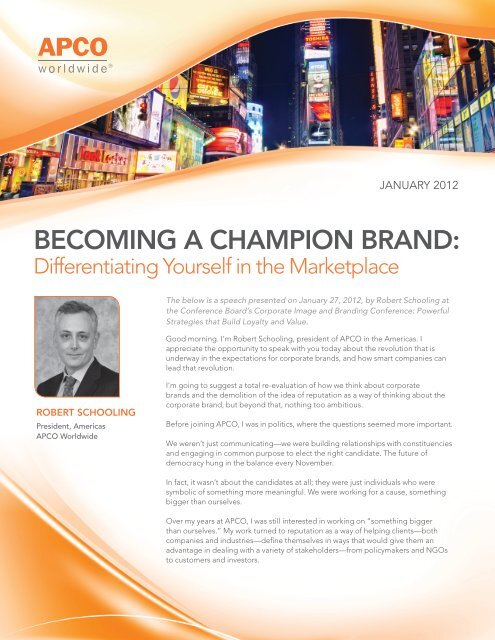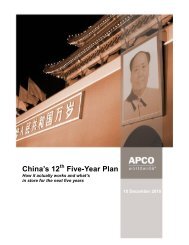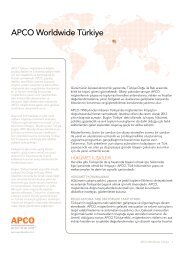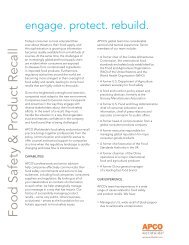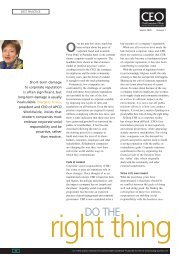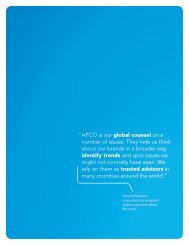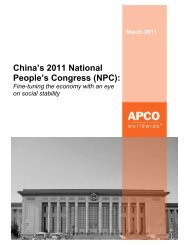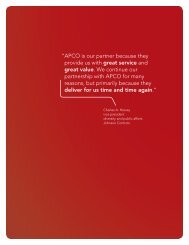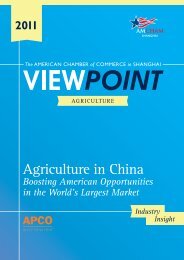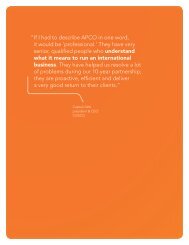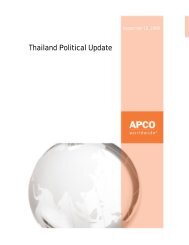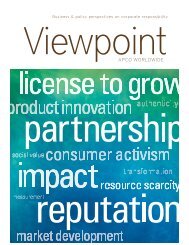Becoming a cHamPion BRanD: - APCO Worldwide
Becoming a cHamPion BRanD: - APCO Worldwide
Becoming a cHamPion BRanD: - APCO Worldwide
You also want an ePaper? Increase the reach of your titles
YUMPU automatically turns print PDFs into web optimized ePapers that Google loves.
<strong>Becoming</strong> a <strong>cHamPion</strong> <strong>BRanD</strong>:<br />
Differentiating Yourself in the Marketplace<br />
RoBeRt ScHooling<br />
President, Americas<br />
<strong>APCO</strong> <strong>Worldwide</strong><br />
1<br />
JANUARY 2012<br />
The below is a speech presented on January 27, 2012, by Robert Schooling at<br />
the Conference Board’s Corporate Image and Branding Conference: Powerful<br />
Strategies that Build Loyalty and Value.<br />
Good morning. I’m Robert Schooling, president of <strong>APCO</strong> in the Americas. I<br />
appreciate the opportunity to speak with you today about the revolution that is<br />
underway in the expectations for corporate brands, and how smart companies can<br />
lead that revolution.<br />
I’m going to suggest a total re-evaluation of how we think about corporate<br />
brands and the demolition of the idea of reputation as a way of thinking about the<br />
corporate brand, but beyond that, nothing too ambitious.<br />
Before joining <strong>APCO</strong>, I was in politics, where the questions seemed more important.<br />
We weren’t just communicating—we were building relationships with constituencies<br />
and engaging in common purpose to elect the right candidate. The future of<br />
democracy hung in the balance every November.<br />
In fact, it wasn’t about the candidates at all; they were just individuals who were<br />
symbolic of something more meaningful. We were working for a cause, something<br />
bigger than ourselves.<br />
Over my years at <strong>APCO</strong>, I was still interested in working on “something bigger<br />
than ourselves.” My work turned to reputation as a way of helping clients—both<br />
companies and industries—define themselves in ways that would give them an<br />
advantage in dealing with a variety of stakeholders—from policymakers and NGOs<br />
to customers and investors.
<strong>Becoming</strong> a <strong>cHamPion</strong> <strong>BRanD</strong>:<br />
Differentiating Yourself in the Marketplace<br />
At the same time, something was changing. All the old castles crumbled. The walls<br />
came down. We’ve heard a lot during this conference about the transformation<br />
we are all going through. But I don’t think we can overstate the extent of<br />
this transformation or the extent to which its implications should be seen in<br />
fundamental—not just tactical—ways.<br />
I believe we are in the early stages of a reevaluation of the relationship between<br />
people and companies—and for companies, that reevaluation is going to create<br />
winners and losers.<br />
Muhammad Ali wasn’t just the greatest boxing champion of all time, he was also a<br />
social activist whose words still have the ring of truth today: “It isn’t the mountains<br />
ahead to climb that wear you out; it’s the pebble in your shoe.”<br />
Two different pebbles in our metaphorical shoes have transformed the way<br />
companies need to do business if they want to get to the top of the mountain:<br />
1. Technology has upended the relationship between individuals and companies<br />
by democratizing information. Corporate information is available anytime,<br />
anywhere—and because only a fraction of that information comes from the<br />
company itself, the result is blurred and limited message control. Information<br />
is no longer mediated by the media and other institutions. As a consequence,<br />
the ability of traditional communications to control corporate imagery has<br />
been radically diminished.<br />
2. The expectations for companies have changed. We are seeing governments’<br />
ability to meet needs weaken and the scale of corporations grow inexorably<br />
larger. The lines are blurring between the province of government and<br />
the province of corporations—and like government, the companies need<br />
the permission of the people to operate and succeed. As a consequence,<br />
stakeholders’ expectations of companies are not only increasing but<br />
increasingly important to the success of the company.<br />
The most successful companies, the Champion Brands, will need to keep pace with—or<br />
better yet, get ahead of—the revolution in communications wrought by technology at a<br />
time when expectations of companies have increased exponentially.<br />
As we think about these trends and the implications for creating greater corporate<br />
brand value, we first need to recognize that the people we are talking to have also<br />
changed.<br />
The NeW STAkehOlder hAS GreAT exPeCTATiONS<br />
Muhammad Ali famously said, “A man who views the world the same at fifty as he did<br />
at twenty has wasted thirty years of his life.” If you still think about your stakeholders the<br />
way you did five years ago, The Champ would tell you you’ve wasted the last five years.<br />
2
<strong>Becoming</strong> a <strong>cHamPion</strong> <strong>BRanD</strong>:<br />
Differentiating Yourself in the Marketplace<br />
WhO Are The NeW STAkehOlderS, ANd WhAT dO They WANT?<br />
The new stakeholder is:<br />
1. Often self-appointed<br />
2. Feels invested in the success of your company<br />
3. Expects companies to be champions for their interests<br />
I like to think of this modern stakeholder as the new Renaissance person. This<br />
new Renaissance person is no longer defined by a single characteristic like their<br />
occupation or place of residence. They wear multiple hats—they are simultaneously<br />
an accountant, a mother, a community volunteer, an investor and an environmental<br />
activist. The traditional means of segmenting people or groups into discrete<br />
audiences is over.<br />
The old “Renaissance man” was someone of high culture who spoke five languages<br />
and read Plato in the original Greek—but this new incarnation is much more<br />
democratized, a function of ideas and engagement, not just knowledge alone. In the<br />
new world almost anyone can be a new Renaissance person.<br />
The new Renaissance stakeholder is invested in the success of your business. They are<br />
financially invested—witness the huge increase in the number of people who actually<br />
own shares in companies and actively manage these portfolios. But these people also<br />
are invested because you are:<br />
• Creating jobs<br />
• Influencing public policy<br />
• Determining whether communities thrive or die<br />
• Creating a cleaner, healthier environment<br />
• And on, and on<br />
Indeed, these people understand and recognize that a company’s influence often<br />
outpaces the influence that government can have on their lives.<br />
We need to undergo a mind-shift in the way we think about all these people—these<br />
stakeholders—who matter to us. Because they have real power and influence, they<br />
are no longer “audiences.” They are truly partners in the success of your enterprise<br />
who have very specific and informed opinions about your company. We can’t expect<br />
to only share information with them—we also have to share power with them.<br />
3
The NeW STAkehOlder NeedS TO be eNGAGed<br />
<strong>Becoming</strong> a <strong>cHamPion</strong> <strong>BRanD</strong>:<br />
Differentiating Yourself in the Marketplace<br />
These new stakeholders understand that something sits behind the product brands—<br />
that there is a corporate entity that can and should be engaged with them.<br />
• Corporate sloganeering is now dismissed as cynical. It isn’t enough to have<br />
clever advertising—stakeholders are looking for a relationship.<br />
• Having a Facebook page and Twitter handle are tactics, not strategies. Of<br />
course, we need to be digitally engaged—but we need to know where that<br />
engagement is taking us.<br />
• Corporate responsibility and philanthropy can be important tools, but they<br />
only address a certain group of stakeholders and don’t always speak to the<br />
core values of the company operating in society. They, too, need to be part of<br />
a singular integrated vision for how the company enters into a relationship with<br />
its stakeholders.<br />
There was an interesting study published recently by Harvard that looked at what they<br />
called “high-sustainability” companies—those that more fully embraced sustainable<br />
business practices, non-financial reporting and certain governance practices. The<br />
study found that those companies substantially outperformed other companies that<br />
did not adopt those same measures.<br />
My suspicion is that this study is a clue to something larger—that these companies<br />
are more likely to be better at building relationships and engaging sustainably with a<br />
variety of stakeholders—not just those traditionally defined by “sustainability.”<br />
Real engagement is the way Champion Brands will be built in this new environment.<br />
Creating enduring, non-transactional relationships between companies and their<br />
stakeholders is the way to get the pebbles out of our shoes and climb up the mountain.<br />
The relationships we help create open the door not only for creating stronger<br />
brands, but also for gaining better insights about the marketplace and identifying<br />
opportunities to create more innovative solutions that will pay off for both the<br />
corporation and its stakeholders.<br />
eNduriNG relATiONShiPS CreATe eNduriNG brANd VAlue<br />
Warren Buffett said, “It takes 20 years to build a reputation and five minutes to<br />
ruin it.” In the current environment, I think that sentiment is truer than ever—and<br />
a reasonable conclusion for a CEO to draw is that we shouldn’t be investing in<br />
reputation if it is so easily destroyed. I agree.<br />
4
<strong>Becoming</strong> a <strong>cHamPion</strong> <strong>BRanD</strong>:<br />
Differentiating Yourself in the Marketplace<br />
We need to create a new way of thinking about corporate brands that is more<br />
enduring.<br />
We are now in an environment where the idea of reputation has limited utility and<br />
meaning. When stakeholders can mobilize opinion and allies in minutes, reputation<br />
as we know it is temporal. Companies that rely on the idea of reputation alone in<br />
building their corporate brand are going to lose ground.<br />
After all, we’ve all watched companies whose good reputations have come crashing<br />
down to earth when faced with bad facts. For many companies there appears to be<br />
cyclicality to their reputation, while other companies are more resistant to downturns.<br />
What is the difference between them?<br />
We’ve deduced some important trends when looking at our clients and over a<br />
decade of research. There are qualities that separate the merely good corporate<br />
brands from the Champion Brands—qualities that make them more resistant to bad<br />
news, better able to adapt to changing market conditions and better able to innovate<br />
and succeed.<br />
So the question we set out to answer was whether or not there was a methodology,<br />
both for research as well as for implementation, that could yield better results—<br />
an approach to creating Champion Brands that would be more meaningful, less<br />
mercurial and better suited to this new environment.<br />
buildiNG A ChAmPiON brANd: The FOur A’S<br />
We developed a new way to measure, understand and ultimately create corporate<br />
value by creating Champion Brands. Our model is based on what we call the “Four<br />
A’s.” Think of it as a credit rating for your brand—are you a single A-, double A-, triple<br />
A- or quadruple A-rated brand?<br />
1. The first A is Alignment: This is the extent to which you are aligned with the<br />
expectations of your stakeholders. We can identify the most persuasive ways<br />
to close the gap between current perceptions and stakeholder expectations.<br />
It’s the way almost all corporate and reputation research is done, and it is a<br />
critical first step—without it you can’t progress through the other stages. But it<br />
isn’t sufficient.<br />
2. The second A is Attachment: Most companies understand the need to<br />
create an emotional connection between their products or services and their<br />
customers. But few companies understand the need to create an emotional<br />
connection between stakeholders and the company itself. Companies are<br />
brands too, and stakeholders need to feel an attachment to, and have a<br />
relationship with, the company.<br />
5
<strong>Becoming</strong> a <strong>cHamPion</strong> <strong>BRanD</strong>:<br />
Differentiating Yourself in the Marketplace<br />
Pushing those disciplines together would be a good start—but still not enough.<br />
3. In the world we live in—of increasing transparency—there is a third A—<br />
Authenticity. Companies must say what they mean, mean what they say and do<br />
what they say. The degree to which their actions and words are truly reflective<br />
of their corporate character is critical. There has been a fair amount of good<br />
thinking and writing done about this from groups like the Page Society and<br />
others. They claim that the best companies find the sweet spot for their brand<br />
in the places where they are truly most able to make a difference in the lives of<br />
all of their stakeholders, and to do so sustainably within their business model.<br />
Building a positioning on a false premise is doomed to fail. I don’t think we need to<br />
name names, but we’ve all seen companies that have attempted to be something<br />
they are not. The results are a huge waste of resource and a cynicism about the brand<br />
that is hard to erase.<br />
When companies are aligned, create attachment and are authentic, they have a very,<br />
very strong brand. But there’s a fourth step to become a Champion Brand.<br />
The ChAmPiON brANd iS AN AdVOCATe FOr iTS STAkehOlderS<br />
There is an old saying in politics that “great campaigns are about the voter, and bad<br />
campaigns are about the candidate.” This is particularly apt as we think about the<br />
meaning of corporate brands in the current environment. In addition to Alignment,<br />
emotional Attachment, and Authenticity stands the fourth differentiating factor:<br />
Advocacy—standing for something bigger than yourself.<br />
Instead of thinking about how to turn our various stakeholders into “brand<br />
champions” for us, we should be asking how we can become champions for our<br />
mutual interests. To paraphrase John F. Kennedy, ask not what your stakeholders can<br />
do for you, ask what you can do for your stakeholders.<br />
Companies are now being asked to show how they add value to society. Don’t<br />
mistake advocacy for cause marketing, or corporate responsibility, or philanthropy—<br />
they are all potential subsets of the idea, but not the idea itself. Advocacy is about<br />
what you stand for—explaining why you’re in business in a way that works in common<br />
cause with your stakeholders. It means acting on your mutual values. It means<br />
building your business while improving society.<br />
The very best and most powerful brands in the world already do this. They stand for<br />
something bigger than themselves, and in the conduct of their business they are<br />
also advocates for their stakeholders. Their customers and their stakeholders believe<br />
that the company is actively working for their interests, and because of that, they are<br />
willing to give the company the benefit of the doubt when and if it slips.<br />
6
<strong>Becoming</strong> a <strong>cHamPion</strong> <strong>BRanD</strong>:<br />
Differentiating Yourself in the Marketplace<br />
We also found that this insight has tangible meaning in the execution of traditional<br />
programs. We were able to show quantitatively that the impact of communications<br />
was greatly enhanced when the nature of the communication was oriented toward<br />
engagement and advocating common cause rather than toward conveying information.<br />
Most importantly, Champion Brands generate outcomes that strengthen their<br />
business—they are better able to avoid the cyclical effects of a reputation based<br />
solely on dry and changing facts. Champion Brands talk differently, act differently<br />
and build more enduring relationships with their stakeholders than other brands that<br />
simply have good reputations.<br />
ChAmPiON brANdS PerFOrm beTTer<br />
We’ve seen in our research a clear correlation between perceptions of the corporate<br />
brand and business outcomes such as sales, employee loyalty, policy outcomes and<br />
shareholder value.<br />
Let me give you a few examples from two different industries:<br />
First, we recently conducted a study of the retail industry. Our research found that<br />
companies that create two-way dialogue—that truly engage—with the communities<br />
in which they operate are more likely to have favorable business outcomes. Our<br />
analysis revealed that improving perceptions of companies in the retail sector by only<br />
one point on our Index (from 0-100) leads to:<br />
• Greater spending by consumers—$133 more per year for the average<br />
consumer. If every retail company in the United States moved up the ladder one<br />
point toward being a Champion Brand, we could inject nearly $35 billion into<br />
the economy and the retail sector.<br />
• Enhanced employee engagement and retention—503,000 more retail<br />
employees would stay with their companies.<br />
• Stronger shareholder value to the tune of half a percentage point increase in<br />
market capitalization (that’s many billions of dollars for some of the largest retail<br />
companies).<br />
These tangible business results apply to not only those companies with<br />
prominent consumer-facing brands. We have also found that in industries like the<br />
pharmaceutical sector, where the corporate brand is several steps removed from<br />
the consumer, those companies that are seen as advocates for society and their<br />
stakeholders perform better. The research shows that standing for something bigger<br />
than producing safe and innovative products leads to stronger brands. Specifically,<br />
we discovered that being seen as a leader in addressing public health challenges,<br />
such as chronic disease, is a key opportunity to improving perceptions and business<br />
7
<strong>Becoming</strong> a <strong>cHamPion</strong> <strong>BRanD</strong>:<br />
Differentiating Yourself in the Marketplace<br />
outcomes. The data shows that companies that improve perceptions of their brand by<br />
only one point would see:<br />
• An average increase in annual sales of 3.33 percent.<br />
• An additional 83,000 activists actively and vocally speaking on behalf of the<br />
company.<br />
Investing in your corporate brand isn’t only about being trusted or admired—it’s about<br />
being more successful. These are tangible metrics executives and Boards of Directors<br />
will expect from us. Our model proves that it really pays to be a Champion Brand.<br />
ChAmPiON brANdS FulFill A NeW CONTrACT WiTh STAkehOlderS<br />
I’d like to conclude by discussing what I think this means in the big picture for all of<br />
us—both wearing our hats as stakeholders and as representatives of our companies.<br />
Building a Champion Brand is about embracing a new contract that reframes the<br />
relationships between companies and their stakeholders.<br />
Just as governments have always needed the permission of the people to operate<br />
and succeed, and companies then required a “license to operate” from governments,<br />
companies now need the direct permission of their stakeholders to grow.<br />
This new contract is based on working in common cause to add value to society while<br />
adding value to the company. It leads to more direct interactions, more successful<br />
negotiations and better results for both stakeholders and corporations.<br />
Advocacy is at the core of this new contract. The new stakeholder demands it. Growth<br />
requires it. Now there’s a methodology both for research and implementation that<br />
pinpoints a company’s need to advocate based on shared values, creates advocacy<br />
programs based on common cause, and pays back in predictable, tangible ways. We<br />
know it pays back, because we measure the outcomes.<br />
I think the good news for people in our business is that we have an opportunity to help<br />
shape reality, not just react to it. We are at a critical turning point—and all of us in this<br />
room are lucky to be at the right place at the right time to do something about it.<br />
Thank you for your time today. I’d be happy to answer any questions.<br />
For more information about the Champion Brand, please visit www.apcochampionbrand.com.<br />
© 2012 <strong>APCO</strong> <strong>Worldwide</strong> Inc. All rights reserved. Design: Studio<strong>APCO</strong> ®<br />
8


